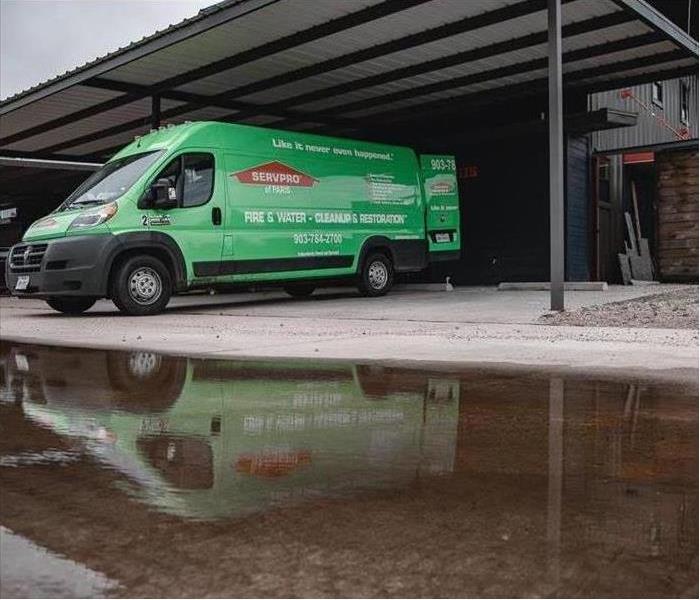Why Should I Call Professionals for Water Cleanup and Restoration?
10/5/2022 (Permalink)
 After your home suffers water damage, you need a team of professionals to assist you with cleanup. Call SERVPRO right away! We are always available.
After your home suffers water damage, you need a team of professionals to assist you with cleanup. Call SERVPRO right away! We are always available.
SERVPRO Offers 24/7 Emergency Service to Handle Your Water Damage Restoration Needs
A sudden water intrusion like a leaking pipe or the breakdown of your water tank can be a sizable inconvenience. However, this inconvenience turns into a substantial loss if not addressed quickly and using the right methods. Hiring trained water restoration technicians (WRT) to come to your Paris home helps you limit the loss and get your home back to normal faster than DIY methods alone.
What is SERVPRO’s Response Plan for Water Damage?
Whenever we get called for water damage restoration, we formulate a plan based on any combination of methods to help us:
- Minimize the need for demolition
- Repair or restore rather than replace
- Create an optimum atmosphere for drying, such as closed drying systems
- Expedite restoration to have you back to your routine fast
How is the Need for Demolition Determined?
With many water removal projects demolition is required to remove any wet structural components or wall materials. Controlled or partial demolition efforts allow us to remove and replace just a portion of the materials to have it finished off to match the preloss condition. Our team always uses a variety of non-invasive techniques to ensure no moisture is left behind, including:
- Moisture sensors
- Moisture detectors
- Thermal cameras
Of course, whenever your interior has standing water, we use extraction tools and a combination of methods to facilitate faster removal. Some of the standard options our SERVPRO technicians will use include:
- Submersible pumps
- High-powered extractors
- Draining any trapped water behind walls using bore-holes
- Mopping
- Wet-Vac, and more
Why Should I Have SERVPRO Restore My Carpets?
We are well-versed in best practices for restoring carpeting impacted by water loss within the home. Upon arrival and formulation of our restoration plan, we inspect your carpeting and select the best equipment and methods to achieve our goals. The process includes:
- Inspecting carpeting using moisture probe technology – this allows us to determine how deep the moisture has embedded into the carpet and the pad below.
- Detachment of the carpet with the proper tools so our technicians can further inspect to see if the carpet has delaminated or mold has begun to colonize.
- In cases where the water has not infiltrated the carpet pad or the subfloor below, we may use centrifugal air movers to float the carpet, thus allowing warm air to circulate beneath.
- In cases where water moisture saturates the carpet fully, we will remove the padding below and dispose of it to be replaced after the drying of the zone is complete.
In general, carpet detachment is the fastest way to facilitate drying as it allows air to flow underneath. However, we have some in-place drying methods that will enable us to achieve drying goals without detachment. This may involve using a weighted extractor, or rover, that works from the perimeter inward while drying. In-place drying is ideal when moisture has not made it all the way down to the carpet padding.
Why is Professional Restoration Better Than DIY?
What many homeowners may not realize is that there does not have to be extensive water damage for it to add up to an immense loss. There could be hidden moisture left behind in wall cavities and other tight spots that make it difficult for DIY methods to get the job done. SERVPRO features IICRC-certified technicians that have the choice between two distinct systems to ensure your home is back to appropriate humidity levels. These systems include:
- Open Drying System – This works by using outside air to speed up the drying of the impacted area. Warmer months allow us to use an open system for active, time-efficient drying. This method helps to promote evaporation while using equipment like air-movers and box fans to exchange evaporated moisture with drier outside air. We can do this by opening up doors and windows in conjunction with a centrifugal motion to create fluid air movement.
• Closed Drying System – This system works by using dehumidification equipment within a concentrated drying zone for air exchange. Such a method is excellent during times of the year when temperatures are lower, and access to the outdoors is limited. This works on the same principle, yet a closed system gives more control of the temperatures. Higher temps mean the air holds more moisture, and drying is faster. We also use desiccant dehumidifiers within the work zone for moisture removal and to thwart the potential for mold growth.






 24/7 Emergency Service
24/7 Emergency Service